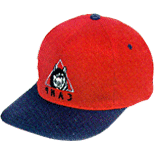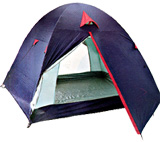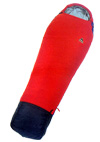Equipment needed depends largely upon where,
when and how one is trekking. The main emphasis  while
trekking is on keeping warm and dry while still being lightweight.
For lower altitude, fleece jackets and pants are adequate, while
at higher altitudes down jackets are advisable. Waterproof, wind-proof
jackets and pants, well broken-in footwear, head covering are also
recommended. Good sleeping bags, sunglasses, drinking water bottle,
torchlight, sun block cream, toiletries, first aid kit and a very
good route map are other items necessary. Cameras, on the other
hand are hand are handy for taking home memories. while
trekking is on keeping warm and dry while still being lightweight.
For lower altitude, fleece jackets and pants are adequate, while
at higher altitudes down jackets are advisable. Waterproof, wind-proof
jackets and pants, well broken-in footwear, head covering are also
recommended. Good sleeping bags, sunglasses, drinking water bottle,
torchlight, sun block cream, toiletries, first aid kit and a very
good route map are other items necessary. Cameras, on the other
hand are hand are handy for taking home memories.
Trekking equipments are available in Kathmandu, Pokhara
and Namche Bajaar.
Health and Medicine:
Medication shops are few on trekking routes. Therefore, it is best
to carry first aid kit and read about the possible problems before hand. On the Everest base Camp route
at Pheriche and and on the Annapurna Circuit route at Manang, there
are clinics operated by the Himalayan rescue Association that specializes
in treating trekker’s health problems. These clinics are open
only during the main trekking seasons. While on treks, the following
problems could occur:
the possible problems before hand. On the Everest base Camp route
at Pheriche and and on the Annapurna Circuit route at Manang, there
are clinics operated by the Himalayan rescue Association that specializes
in treating trekker’s health problems. These clinics are open
only during the main trekking seasons. While on treks, the following
problems could occur:
- Upset stomach, often caused by change in diet or contaminated
food and water is a common ailment. To avoid it, one should pay
particular attention to hygiene and quality of food and drinks.
- Cough, cold, sore throats, common in the dry mountain air can
lead to chest infection. Sore throats can best be avoided by attempting
not tot breathe cold air directly though mouth. Smoking should
also be avoided.
 Joint muscle strains, foot problems and blisters are other hindrances
for trekkers. Wearing good footwear will go a long way in avoiding
these problems. For sprains and strains, apply cold water to reduce
swelling and support the joint with crepe bandage.
Joint muscle strains, foot problems and blisters are other hindrances
for trekkers. Wearing good footwear will go a long way in avoiding
these problems. For sprains and strains, apply cold water to reduce
swelling and support the joint with crepe bandage.- Acute Mountain Sickness (AMS) is a fatal sickness caused by
random altitude ascension. Therefore climbers ascending 3,000
meters or above should acquire sound knowledge of proper acclimatization
processes. Symptoms of AMS include headache, loss of appetite,
swelling of limbs, dizziness, difficulty in sleeping, irregular
breathing, nausea and unusual weariness. Maintaining good fluid
intake helps combat altitude sickness and hurried descent or evacuation
to lower altitude is the only best cure.
|
Safety and security:
Nepal is a safe country to trek provided the basic rules are observed.
When with trekking agency  most
contingencies are handled by anger staff. However, one could get
lost or hurt and have no one to ask for help when trekking alone.
Therefore, trekkers should either trek with agencies, or hire reliable
guides are available for women trekkers. The nest way to avoid risk
while trekking is through through planning, playing by the rules
and realizing human limitations. In case of misfortune, a short
detailed message should be dispatched to a reliable organization
or individual immediately for rescue operation. If communication
facilities are unavailable, normal first aid principles should be
followed till help arrives. Some of the safety rules to abide by
are: most
contingencies are handled by anger staff. However, one could get
lost or hurt and have no one to ask for help when trekking alone.
Therefore, trekkers should either trek with agencies, or hire reliable
guides are available for women trekkers. The nest way to avoid risk
while trekking is through through planning, playing by the rules
and realizing human limitations. In case of misfortune, a short
detailed message should be dispatched to a reliable organization
or individual immediately for rescue operation. If communication
facilities are unavailable, normal first aid principles should be
followed till help arrives. Some of the safety rules to abide by
are:
- Do not trek alone.
- Do not make a display of wealth.
- Keep belongings secure and within sight.
- Make arrangements for handling emergency situations before
hand.
- Register personal information and trekking plan details with
respective embassies.
- Buy travel insurance policy that covers helicopter rescue cost.
Leave a copy of details with an agency in Kathmandu.
- Choose only authorized government registered trekking agencies,
guides and porters.
|
Environmental
issue;
A general advise to trekking is to leave only footprints and take
only photographs. However, the recent developments along trekking
trails have been of concern to environmentalists and locals alike.
The sprouting of teahouses along trekking trails demand wood for
construction and fuel, which has led to deforestation. In addition,
the amount of waste has increased without proper mechanism for disposal,
making some of the popular trails both unsightly and unhealthy.
With increased awareness on the part of trekkers and local people,
this trend is changing. However, message still needs to be passed
across for a more environmentally sound trekking. For vigilant trekking
the following rules must be followed:
- Ensure that your trekking company supplies sufficient kerosene
or gas got cooking.
- Dispose biodegradable waste properly and carry non-biodegradable
waste out or dump them in properly constructed waste pit.
- Ensure that campsites are left clean and that toilet pits are
properly filled in after use.
|
| Email us for further information:
info@nepaltrekking.com.np |




 while
trekking is on keeping warm and dry while still being lightweight.
For lower altitude, fleece jackets and pants are adequate, while
at higher altitudes down jackets are advisable. Waterproof, wind-proof
jackets and pants, well broken-in footwear, head covering are also
recommended. Good sleeping bags, sunglasses, drinking water bottle,
torchlight, sun block cream, toiletries, first aid kit and a very
good route map are other items necessary. Cameras, on the other
hand are hand are handy for taking home memories.
while
trekking is on keeping warm and dry while still being lightweight.
For lower altitude, fleece jackets and pants are adequate, while
at higher altitudes down jackets are advisable. Waterproof, wind-proof
jackets and pants, well broken-in footwear, head covering are also
recommended. Good sleeping bags, sunglasses, drinking water bottle,
torchlight, sun block cream, toiletries, first aid kit and a very
good route map are other items necessary. Cameras, on the other
hand are hand are handy for taking home memories. the possible problems before hand. On the Everest base Camp route
at Pheriche and and on the Annapurna Circuit route at Manang, there
are clinics operated by the Himalayan rescue Association that specializes
in treating trekker’s health problems. These clinics are open
only during the main trekking seasons. While on treks, the following
problems could occur:
the possible problems before hand. On the Everest base Camp route
at Pheriche and and on the Annapurna Circuit route at Manang, there
are clinics operated by the Himalayan rescue Association that specializes
in treating trekker’s health problems. These clinics are open
only during the main trekking seasons. While on treks, the following
problems could occur: Joint muscle strains, foot problems and blisters are other hindrances
for trekkers. Wearing good footwear will go a long way in avoiding
these problems. For sprains and strains, apply cold water to reduce
swelling and support the joint with crepe bandage.
Joint muscle strains, foot problems and blisters are other hindrances
for trekkers. Wearing good footwear will go a long way in avoiding
these problems. For sprains and strains, apply cold water to reduce
swelling and support the joint with crepe bandage. most
contingencies are handled by anger staff. However, one could get
lost or hurt and have no one to ask for help when trekking alone.
Therefore, trekkers should either trek with agencies, or hire reliable
guides are available for women trekkers. The nest way to avoid risk
while trekking is through through planning, playing by the rules
and realizing human limitations. In case of misfortune, a short
detailed message should be dispatched to a reliable organization
or individual immediately for rescue operation. If communication
facilities are unavailable, normal first aid principles should be
followed till help arrives. Some of the safety rules to abide by
are:
most
contingencies are handled by anger staff. However, one could get
lost or hurt and have no one to ask for help when trekking alone.
Therefore, trekkers should either trek with agencies, or hire reliable
guides are available for women trekkers. The nest way to avoid risk
while trekking is through through planning, playing by the rules
and realizing human limitations. In case of misfortune, a short
detailed message should be dispatched to a reliable organization
or individual immediately for rescue operation. If communication
facilities are unavailable, normal first aid principles should be
followed till help arrives. Some of the safety rules to abide by
are: